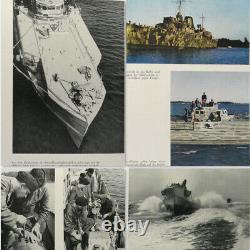WW2 Navy E-Boat Schnellboot Photo Book 1943 Patrol PT Boat Kriegsmarine Finland


A first-hand account of the finnish operations of a patrolboat/e-boat flotilla in the eastern theater. An excellent wartime pictorial of operations based in Finland. This book is quite scarce. An old published book review states. The magnificent, original photographs and descriptive reporting of war correspondent Hugo Bürger combine to accurately portray the bold raids of the powerful, German Navy torpedo boats undertaken against the forces of the Soviet Union. From the extremely intense moments experienced in the heat of battle, to the friendly comradeship and lighthearted moments of military daily routine, this book conveys to the reader a realistic view of the spirit and accomplishments of this newest branch of the wartime naval service. 104 very rare b&w photos. Good exterior and very good interior. Backstrip replaced, boards slightly dusty/soiled, otherwise ok with minor traces of use and age. All pages are complete and tight in the binding. Approx/Measurements: 10-1/2" x 8-1/4" 1.4 lbs.
After the Treaty of Versailles most of Germany's military production was severly curtailed. Small patrol craft were not. The E-boats trace their lineage back to a private motor yacht - a 22 ton dispacement 34 knot craft called Oheka II, which had been built in 1927 for wealthy financier and patron of the arts, Otto Kahn, by the German shipbuilding company Lürssen. As such they would be up against Royal Navy and Commonwealth contingents in Motor Gun Boats (MGBs) and Motor Torpedo Boats (MTBs) as well as Motor Launchs and destroyers. Crews could earn an award particular to their work - denoted by a badge depicting an E-boat passing through a wreath.
The criteria were good conduct, distinction in action, participating in at least twelve enemy actions. It was awarded for a particularly successful mission, displays of leadership or being killed in action. It could also be awarded under special circumstances such as when another decoration was not suitable. The E-boat design evolved over time. The first had a pair of torpedo tubes on the fore deck. S-26 class Entered service in 1940 40 metre hull.Torpedo tubes covered by forward deck. S-38b class Improved 38 class with armoured bridge. S-100 class From 1943 2 x 20 mm gun amidships and 37 mm gun aft.
Type 700 late war design, never built, stern torpedo tubes and 30 mm gun turret forward.

